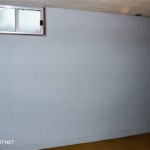How to Cover Cement Walls in Basement
Cement walls in basements can be unsightly and damp, but there are several effective ways to cover them up and improve the look and feel of your basement. Here are the essential aspects of covering cement walls in a basement:
Preparation:
Before covering the cement walls, it's crucial to prepare the surface properly. This includes cleaning the walls thoroughly to remove any dirt, dust, or debris. Any cracks or holes should be filled with a patching compound or caulk to create a smooth surface for the covering.
Moisture Control:
Basements are prone to moisture issues, so it's essential to address any moisture problems before covering the walls. If there's evidence of moisture, such as dampness or mold, consider installing a dehumidifier or a sump pump to control humidity and prevent moisture buildup.
Insulation:
Covering cement walls also provides an opportunity to insulate your basement. Adding insulation to the walls will help regulate temperature, reduce energy costs, and make the basement more comfortable during all seasons.
Covering Options:
There are several options for covering cement walls, including:
- Drywall: Drywall is a popular choice for covering basement walls because it's relatively inexpensive and easy to install. It can be painted or textured to match the décor of your basement.
- Paneling: Wood paneling is another option for covering cement walls. It adds a warm and rustic touch to the basement and can be stained or painted to create a custom look.
- Fabric Wall Coverings: Fabric wall coverings, such as vinyl or fabric-backed wallpaper, can add a touch of elegance to basement walls. They're available in various colors, patterns, and textures to complement any style.
- Tile: Ceramic or porcelain tiles are a durable and waterproof option for covering basement walls. They're easy to clean and maintain, making them a practical choice for basements.
Installation:
The installation process for covering cement walls will vary depending on the chosen material. Drywall and paneling typically require framing, while fabric wall coverings and tiles can be applied directly to the walls using adhesive.
Finishing Touches:
Once the walls are covered, you can add finishing touches to enhance the overall look and functionality of your basement. Consider adding baseboards and crown molding to the walls for a polished finish. You can also install lighting fixtures, shelving, or artwork to create a more inviting and personalized space.
By following these essential aspects, you can effectively cover cement walls in your basement, transforming it into a more comfortable and aesthetically pleasing living space.

Stylish Solutions Covering Unfinished Basement Walls Csg Renovation

Stylish Solutions Covering Unfinished Basement Walls Csg Renovation

10 Ways To Cover Concrete Walls In A Basement Finish

Stylish Solutions Covering Unfinished Basement Walls Csg Renovation

How To Insulate A Basement Wall Greenbuildingadvisor

10 Ways To Cover Concrete Walls In A Basement Finish

10 Ways To Cover Concrete Walls In A Basement Finish

How To Easily Add Knockdown Texture Concrete Basement Walls

Basement Wall Products In Clarksville Nashville Jackson Tennessee Kentucky And Alabama Covering Options For Huntsville Murfreesboro Franklin Bowling Green Athens Smyrna Florence

Basement Finishing Do Not Paint Your Walls
See Also








